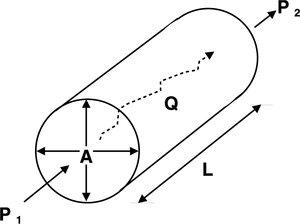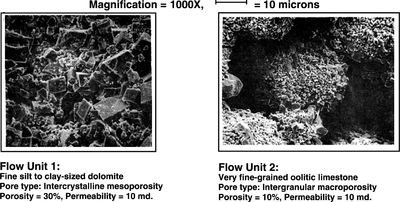What is permeability?
| Exploring for Oil and Gas Traps | |

| |
| Series | Treatise in Petroleum Geology |
|---|---|
| Part | Predicting the occurrence of oil and gas traps |
| Chapter | Predicting reservoir system quality and performance |
| Author | Dan J. Hartmann, Edward A. Beaumont |
| Link | Web page |
| Store | AAPG Store |
Absolute permeability (Ka) is the property of a rock that characterizes the flow of fluid through its interconnected pores. It is a measure of the fluid conductivity of a rock. The permeability of a flow unit in a reservoir is not an absolute value but is a relative value that varies with water saturation (see Relative permeability and pore type). Understanding the methodology for permeability measurements is important for understanding how to assess reservoir rock quality or to compare the quality of one flow unit to another.
Horizontal and vertical ka
Horizontal Ka (i.e., parallel to bedding) is generally greater than vertical Ka (i.e., normal to bedding) because of vertical changes in sorting and because of bedding laminations. High vertical Ka generally results from fracturing or even burrowing that cuts across bedding. Most Ka calculations are made from measurements of horizontal plugs.
Steady-state permeability equation
Permeability is not measured; it is calculated. The steady-state equation for calculating permeability (using an integrated form of Darcy's law) is
where:
- Ka = permeability to air, md
- Patm = atmospheric pressure, atm
- A = cross-sectional area of the plug face, cm2
- Q = flow, cm3/sec
- L = length, cm
- P1 = pressure at input end, atm
- P2 = pressure at output end, atm
- μ = air viscosity, cp
The diagram of a plug in Figure 1 illustrates some of these variables.
Limitations of darcy's equation
Why do two reservoirs with similar Ka but different porosities yield different performances? The standard conversion of air flow through a rock to Ka is accomplished using the Darcy relationship. Since the cross-sectional area (A) is of the plug face and not of the pores exposed on the surface of the plug, this equation cannot adjust for the ratio of number vs. size of pore throats exposed at the end of the plug.
Example
In Figure 2, flow unit 1 is a sucrosic dolomite. On a face of a plug of flow unit 1, a very large number of very small pore throats (capillaries) occur, resulting in a measurable flow (Q). That Q, at a measured cross-sectional area A of the plug, yields a Ka of approximately 20 md.
The sample from flow unit 2 with the same A has fewer, larger pore throats (capillaries) exposed in the face of the plug. If the Q for flow unit 2 is slightly lower than flow unit 1, then the Ka will be lower (by using the same A).
Flow unit 1 has a porosity of 30%, and flow unit 2 has a porosity of 10%. The variance in porosity becomes the indicator of the contrast in pore throat size when converted to port size. For flow unit 1, the port size is approximately 1.1μ; for flow unit 2, port size is approximately 3μ.
See also
- Pore-fluid interaction
- Hydrocarbon expulsion, migration, and accumulation
- Characterizing rock quality
- Pc curves and saturation profiles
- Converting Pc curves to buoyancy, height, and pore throat radius
- Relative permeability and pore type


